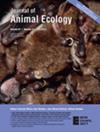Spatiotemporal interactions between ocelots and agoutis in Neotropical protected forests
IF 3.7
1区 环境科学与生态学
Q1 ECOLOGY
引用次数: 0
Abstract




新热带保护林中豹猫与刺鼠的时空相互作用。
了解捕食者和猎物如何在空间和时间上共存是生态学的核心兴趣。现在,世界各地越来越多的照相机陷阱研究提供了大量的摄影探测数据。这些数据增强了我们研究生态学中一个难以捉摸但重要的主题的能力:物种在空间和时间上的相互作用。在此,我们研究了保护区中典型的夜间和黄昏捕食者和白天猎物活动的时空配置。我们研究了刺鼠(Dasyprocta leporina)是否会根据潜在捕食者豹猫(Leopardus pardalis)的出现和活动时间来调整活动时间,以及豹猫的出现是否会对猎物的出现做出反应,从而对捕食风险做出反应。利用定制的两个物种的贝叶斯占用模型,我们分析了在巴西和苏里南三个受保护的热带森林(2至9年)收集的相机陷阱数据。我们的模型区分了占用(即空间分布)和检测(即空间和时间上的活动)。我们发现了捕食者和猎物之间的正空间关联,这表明豹猫会寻找有刺鼠的地方。而不是在空间中隔离,刺鼠似乎通过减少活动来应对增加的捕食风险。在黄昏时分,豹猫出没的地方,刺鼠活动(即被发现的概率)的减少最为明显。我们的研究结果说明了如何在空间和时间上共同建模相互作用,从而帮助我们理解捕食者-猎物共存。
本文章由计算机程序翻译,如有差异,请以英文原文为准。
求助全文
约1分钟内获得全文
求助全文
来源期刊

Journal of Animal Ecology
环境科学-动物学
CiteScore
9.10
自引率
4.20%
发文量
188
审稿时长
3 months
期刊介绍:
Journal of Animal Ecology publishes the best original research on all aspects of animal ecology, ranging from the molecular to the ecosystem level. These may be field, laboratory and theoretical studies utilising terrestrial, freshwater or marine systems.
 求助内容:
求助内容: 应助结果提醒方式:
应助结果提醒方式:


